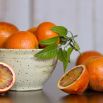
A lot of you might have heard quinoa from people who are following a particular diet, especially for weight loss. Quinoa, with a scientific name Chenopodium quinoa, is a type of seed that comes from a plant. It is considered to be a part of the superfood family and has higher nutrient content compared to other grains.
Although quinoa is prepared and eaten the same way as grains, it is not entirely considered as a relative to wheat, rice, and oats. The reason for that is because quinoa does not grow on the grass.
Characteristics of quinoa
Quinoa has a nutty flavor with a crunchy texture, and a lot of people like it and use it as a part of their diet, especially for breakfast. Typically, quinoa is used as an alternative for rice, and it is healthier to eat. The seed is also gluten-free and is perfect for people who are sensitive to gluten products and foods.
Quinoa has a very interesting look. The tiny pieces come in an oval shape, and they are usually in pale yellow colors. Other quinoa has pink and black colors as well, but it does not make any difference from the yellow ones. However, there are quinoa seeds that taste sweet and bitter.
Mostly, people use quinoa as a side dish for their meals. It is often boiled or steamed, just like rice. It is also a great thickening ingredient for soups and stews. You can let the quinoa seeds to sprout, pop them like popcorn, or ground them for smooth mixture in different foods. It is also a healthy snack to feed your babies.
How nutritious is quinoa?
Quinoa is very high in nutrients compared to grains. A cup of quinoa seeds has 222 calories. If you cook it, it has about 21.3% carbohydrates, 71.6% water, 1.92% fat, and 4.4% of protein. When you consume 3.5 ounces of cooked quinoa, you will have 120 calories, 72% water, 4.4 grams of protein, and 21.3 grams of carbohydrates. It also contains 0.9 grams of sugar, 1.9 grams of fat, and 2.8 grams of fiber.
The carbohydrates content in quinoa is 83% starch, while the other percent is fiber. Quinoa has a low glycemic index (GI), which means it will not harm your blood sugar. As for quinoa's fiber content, it is a healthier and better option to take compared to brown rice and yellow corn. It also has resistant starch, which is good for your gut.
Aside from carbohydrates and fiber, quinoa is also rich in protein and is considered to be a complete protein source. The protein type in quinoa is the same as casein, which is a high-quality protein found only in dairy products. Quinoa is also gluten-free, which is a perfect food for people who are allergic to gluten.
Vitamins and Minerals in Quinoa
Quinoa is also an excellent antioxidant and has tons of vitamins and minerals. Among those are manganese, phosphorus, folate, copper, magnesium, iron, and zinc. Aside from these minerals, it also has plant compounds such as saponin, quercetin, squalene, kaempferol, oxalates, and phytic acid.
ALSO READ: Important Facts About the Pioppi Diet









